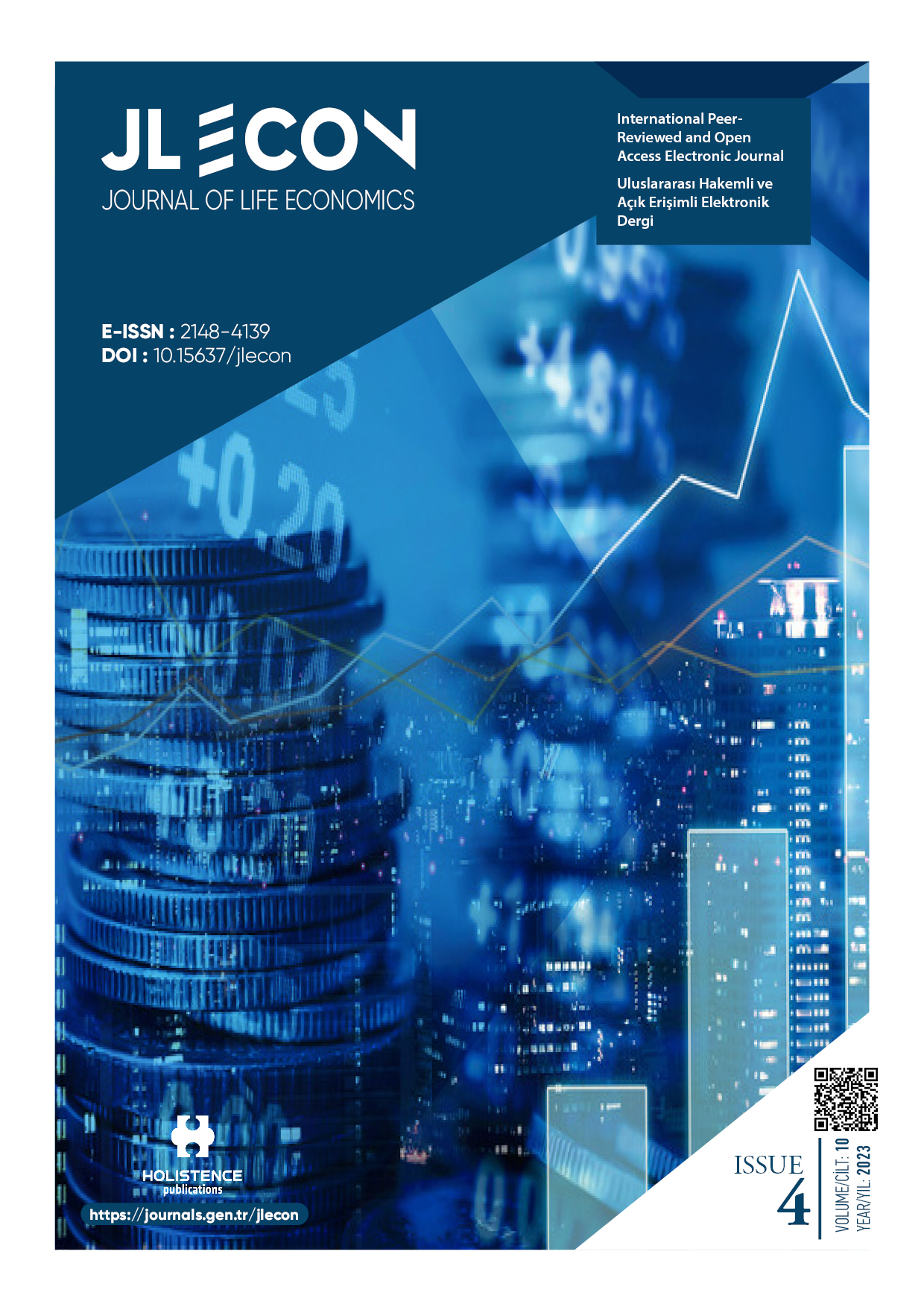How does globalization affect female employment?: A Panel CS-ARDL analysis for transition countries.
DOI:
https://doi.org/10.15637/jlecon.2229Keywords:
Female Employment, Globalization, Transition Countries, Panel Data, CS-ARDLAbstract
Globalization is considered as a process of development for a country procured from the exchange of human capital, technology, and culture, along with many other economic, financial, and cultural factors at the international level. A wide range of studies in labor economics indicate that globalization and female employment are positively associated as job opportunities are enhanced for both males and females. However, others suggest that as opposed to males, once job opportunities increase, job market becomes more competitive in an unfavorable manner for females. This study intends to examine how globalization process affects female employment in transition countries over the period of 23 years from 1995 to 2017. To do this, a panel data consisting of a selected group of 21 transition countries are utilized in the analysis for which the Cross-Sectionally Augmented Autoregressive Distributed Lag model (CS-ARDL) is employed. Our results suggest that globalization is inversely related to female employment in the long run, which in turn suggests that globalization might create obstacles among females if policymakers do not provide any optimal policies to keep the labor market dynamics stable during the globalization process.
Downloads
References
ACAR, S. (2009). Globalization and Labor Markets in the Developing World: Gendered Dynamics, e-cadernos CES. URL: http://journals.openedition.org/eces/290 ; DOI: https://doi.org/10.4000/eces.290
ANDREWS D.W. (2005). Cross-Section Regression With Common Shocks. Econometrica. 73(5):1551–1585. https://doi.org/10.1111/j.1468-0262.2005.00629.x
BAKKER, I. (1994). The Strategic Silence: Gender and Economic Policy. London: Zed
BERSVENDSEN, T. & DITZEN, J. (2021). Testing For Slope Heterogeneity In Stata. The Stata Journal. 21(1), 51-80.
BREUSCH, T., AND A. PAGAN. (1980). The Lagrange Multiplier Test and Its Application To Model Specification In Econometrics. Review of Economic Studies. 47: 239–253.
BUSSMANN, M. (2009). The Effect of Trade Openness on Women’s Welfare and Work Life. World Development. 37 (6): 1027–1038.
CHOPRA, C. (2019). Does Foreign Direct Investment Boost up Women Empowerment: A Panel Data Analysis of Developed and Developing Countries. Wealth International Journal of Money, Banking, Finance. 8, 83–91.
CHUDIK, A. & PESARAN, M.H. (2013) Large Panel Data Models With Crosssectional Dependence: A Survey. CAFE Res Paper. 13(15).
CHUDIK A., MOHADDES, K., PESARAN, M.H. & RAISSI, M. (2016). Long-Run Effects In Large Heterogeneous Panel Data Models With Cross-Sectionally Correlated Errors. Emerald Group Publishing Limited.
CONNELLY, MARIE P., T. MURRAY LI, M. MACDONALD, AND JANE L. PAPART. (1995). Restructured Worlds Restructured Debates: Globalization, Development and Gender. Canadian Journal of Development Studies. Special Issue.
COORAY, A., GADDIS, I., & WACKER, K.M. (2012). Globalization And Female Labor Force Participation In Developing Countries: An Empirical (Re-) Assessment. Courant Research Centre: Poverty. Equity and Growth-Discussion Papers. No. 129.
COORAY, A., DUTTA, N., MALLICK & S. TRADE. (2017). Openness and Labor Force Participation in Africa: The Role of Political Institutions. Industrial Relations: A Journal of Economy and Society. 56, 319–350.
DITZEN, J. (2021). Estimating Long-Run Effects And The Exponent Of Cross-Sectional Dependence: An Update To xtdcce2. The Stata Journal. 21(3), 687-707.
EBERHARDT, M. & TEAL, F. (2013) Structural Change And Cross-Country Growth Empirics. World Bank Economic Review. 27(2):229–271. https://doi.org/10.1093/wber/lhs020
EBERHARDT, M. & PRESBITERO, A.F. (2015) Public Debt and Growth: Heterogeneity And Non-Linearity. Journal of International Economics. 97(1):45–58. https://doi.org/10.1016/j.jinteco.2015.04.005
EVERAERT. G. & DE GROOTE, T. (2016) Common Correlated Effects Estimation Of Dynamic Panels With Cross-Sectional Dependence. Econometric Review. 35(3):428–463. https://doi.org/10.1080/07474938.2014.966635
FAKIH, A., & P. L. GHAZALIAN. (2015). Female Employment In MENA’S Manufacturing Sector: The Implications Of Firm-Related And National Factors. ERF Working Paper Series No. 917. Egypt: Economic Research Forum.
GADDIS, I. & PIETERS, J. (2012). Trade Liberalization and Female Labor Force Participation: Evidence from Brazil. Available online: https://ftp.iza.org/dp6809.pdf
GILLS, D.-S. S. & PIPER, N. (2002). Women and Work in Globalising Asia. Retrieved from file:///C:/Users/HH/Downloads/10.4324_9780203166925_previewpdf.pdf
GROGAN, L. & K. KOKA. Young Children And Women’s Labour Force Participation In Russia, 1992–2004. Economics of Transition. 18:4 (2010): 715–739.
GRAY, M. M., M.C. KITTILSON, & W. SANDHOLTZ. (2006). Women and Globalization: A Study of 180 Countries, 1975-2000. International Organization. 60 (2): 239–333.
HAWKESWORTH, M. E. (2006). Globalization and Feminist Activism, pp. 02, USA: Rowman& Littlefield Publisher, INC
HOSSAIN, A., GHIMIRE, S., VALEVA, A., HARRIGER-LIN, J. (2022). Does Globalization Encourage Female Employment? A Cross-Country Panel Study. World 2022, 3, 206–218. https://doi.org/10.3390/world3020011
HUSSAIN, S. (2012). Growth Effects and the Determinants of Female Employment in Pakistan: A Macro- and Microeconomic Analysis. Bochum: UAMR Studies on Development and Global Governance.
IQBAL, H. & MOHIUDDIN, Z. A. (2022). Impact of Globalization on Female Labor Force Participation in Pakistan. Global Journal for management and Administrative Sciences. 119 ISSN (P):2788-4821 & ISSN (O): 2788-483X Volume 3, Issue 1, Page 119-128, April 30, 2022 (Special Issue)
IM, K. S., PESARAN, M. H., & SHIN, Y. (2003). Testing for Unit Roots in Heterogeneous Panels. Journal of Econometrics. 115(1), 53-74
JOEKES, S. P., & WESTON, A. (1994). Women and the New Trade Agenda. New York
JOMO, K.S. (2003). Globalization, Liberalization and Equitable Development: Lessons from East Asia. Programme on Overarching Concerns, Paper No. 3. UNRISD, Geneva.
KABEER, N. (1994). Reversed Realities: Gender Hierarchies in Development Thought. London: Verso Press.
KOF Swiss Economic Institute database, Access (02.01.2023) via https://kof.ethz.ch/en/forecasts-and-indicators/indicators/kof-globalisation-index.html.
LALL, S. (2002). The Employment Impact of Globalization in Developing Countries. Queen Elizabeth House, Oxford University, pp. 1-22, https://pdfs.semanticscholar.org/e2df/b965bae81c175ab828d61db5910080721508.pdf
LIPS, H. M. (2017). A New Psychology of Women: Gender, Culture, and Ethnicity, Fourth Edition. USA: Waveland Press, Inc
MARCHAND, M.H. & PARPART, J.L. (1995). Feminism/Postmodernism/Development. London: Routledge.
MABROUKI, M. (2022). Patent, Education, Human Capital, And Economic Growth In Scandinavian Countries: A Dynamic Panel CS-ARDL Analysis. Journal of the Knowledge Economy. 1-16.
MARCHAND, M. (1996). Reconceptualizing Gender and Development in the Era of Globalisation. Millennium: Journal of International Studies. 25(3);577-603.
MAQSOOD, F. (2014). Impact of Globalization on Female Labor Force Participation in the SAARC Region. Pakistan Journal of Social Sciences (PJSS). 34, 523–533.
MEYER, L.B. (2001). International Trade Liberalization and Gender Relations in Labor Markets: Cross-National Analysis 1970-1998. Ph.D dissertation. Emory
MOGHADAM, V.M. (1999). Gender and globalization: Female labor and women’s mobilization. Journal of World-Systems Research. 5(2), 367-388. doi. 10.5195/jwsr.1999.139
OKŞAK, Y. & KOYUNCU, J.Y. (2017). Does Globalization Affect Female Labor Force Participation: Panel Evidence. Journal of Economics Bibliography. 4, 381–387.
OKUMUS, I., GUZEL, A. E., & DESTEK, M. A. (2021). Renewable, Non-Renewable Energy Consumption And Economic Growth Nexus In G7: Fresh Evidence From CS-ARDL. Environmental Science and Pollution Research. 28(40), 56595-56605.
ORBETA, A.C. (2002). Globalization and Employment: The Impact of Trade on Employment Level and Structure in the Philippines, Philippine Institute for Development Studies, dirp3.pids.gov.ph/ris/dps/pidsdps0204.pdf
OUR WORLD IN DATA (2023). https://ourworldindata.org/
PESARAN, M. H. (2007). A Simple Panel Unit Root Test in the Presence of Cross-Section Dependence. Journal of Applied Econometrics. 22(2), 265–312. http://www.jstor.org/stable/25146517.
PESARAN, M. H., & YAMAGATA, T. (2008). Testing Slope Homogeneity In Large Panels. Journal of Econometrics. 142(1), 50-93.
PESARAN, M. H., ULLAH, A., & YAMAGATA, T. (2008). A Bias‐Adjusted LM Test Of Error Cross‐Section Independence. The Econometrics Journal. 11(1), 105-127.
PIGNATTI, N. (2020). Encouraging Women’s Labor Force Participation In Transition Countries. IZA World of Labor 2020: 264 doi:10.15185/izawol.264.v2
PHILLIPS P.C., SUL D. (2003) Dynamic Panel Estimation and Homogeneity Testing Under Cross Section Dependence. Econometrics Journal. 6(1):217–259. https://doi.org/10.1111/1368-423X.00108
PHILLIPS, P. C. B. AND D. SUL (2007). Bias In Dynamic Panel Estimation With Fixed Effects, Incidental Trends And Cross Section Dependence. Journal of Econometrics. 137, 162-188.
RATHBERGER, E. (1990). WID, WAD, GAD: Trends in Research and Practice. Journal of developing Societies. 24, 489-502.
RICHARDS, D.L. & GELLENY, R. (2007). Women’s Status and Economic Globalization. International Studies Quarterly. 51, 855–876.
SEGUINO, S. & GROWN, C. (2006). Gender Equity And Globalization: Macroeconomic Policy For Developing Countries. J. Int. Dev. J. Dev. Stud.Assoc. 18, 1081–1104.
SEN, G., & GROWN, C. (1987). Development, Crises, and Alternative Visions. New York: New Feminist Library
SEN, A. (1990). More Than 100 Million Women Are Missing. The New York Review of Books 37 (20): 61–66.
SWAMY, P.A. (1970). Efficient Inference In A Random Coefficient Regression Model. Econometrica: Journal of the Econometric Society. 311-323.
VOUMIK, L.C., RAHMAN, M.H., ISLAM, M.A., CHOWDHURY, M.A.S. & ZIMON, G. (2023). The Impact of Female Education, Trade Openness, Per Capita GDP, and Urbanization on Women’s Employment in South Asia: Application of CS-ARDL Model. Systems, 11, 97. https://doi.org/10.3390/systems11020097
WACKER, K.M., COORAY, A. & GADDIS, I. (2017). Globalization and Female Labor Force Participation in Developing Countries: An Empirical (Re-)Assessment. In Globalization; Christensen, B.J., Kowalczyk, C., Eds.; Springer: Berlin/Heidelberg, Germany, pp. 545–583.
WORLD DEVELOPMENT INDICATOR DATABASE. Access (02.01.2023) via https://databank.worldbank.org/source/world-development-indicators.
Downloads
Published
How to Cite
Issue
Section
License
Copyright (c) 2023 Holistence Publications

This work is licensed under a Creative Commons Attribution 4.0 International License.
When the article is accepted for publication in the Journal of Life Economics, authors transfer all copyright in the article to the Holistence Publications.The authors reserve all proprietary right other than copyright, such as patent rights.
Everyone who is listed as an author in this article should have made a substantial, direct, intellectual contribution to the work and should take public responsibility for it.
This paper contains works that have not previously published or not under consideration for publication in other journals.

















